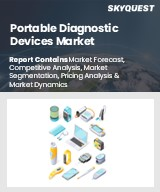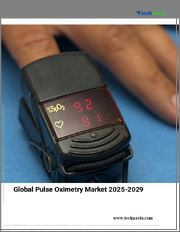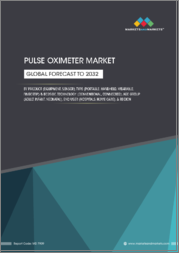
|
시장보고서
상품코드
1405690
뇌체세포 산소 농도계 : 시장 점유율 분석, 산업 동향 및 통계, 성장 예측(2024-2029년)Cerebral Somatic Oximeters - Market Share Analysis, Industry Trends & Statistics, Growth Forecasts 2024 - 2029 |
||||||
뇌체세포 산소 농도계 시장 규모는 2024년 1억 9,121만 달러로 추정되고, 2029년 2억 4,351만 달러로 성장할 전망이며, 예측 기간(2024-2029년)의 CAGR은 6.23%로 예측됩니다.
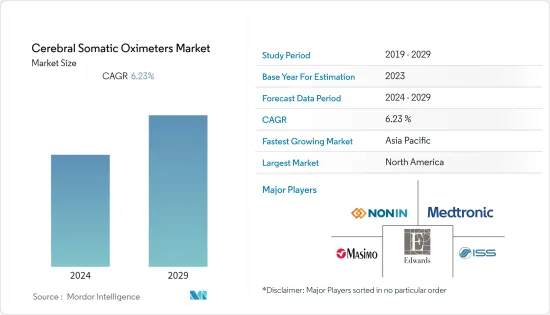
주요 하이라이트
- 뇌체세포 산소 농도계 시장은 COVID-19 팬데믹의 영향을 크게 받았습니다. 팬데믹 발생 이후, 특히 개발도상국에서는 의료기기 공급망의 혼란과 함께 많은 국가에서 선택 수술이 연기되거나 취소되었습니다. 예를 들어, 2022년 5월에 브라질의 교장 수술 서류에 게재된 논문에 따르면, 이집트의 Main University Hospital의 병원 직원은 심장 외과 외래로부터 신규 입원을 연기하고, 팬데믹 기간 동안 현재 입원중인 환자 그리고 응급환자에 한정하여 수술을 하도록 지시되었다고 합니다. 그러나 최근 2년간 세계 각지에서 비필수 의료 시술이 점차 재개되면서 시장이 회복되기 시작했습니다.
- 뇌체세포 산소 농도계 시장은 예측 기간 동안 건전한 성장이 예상됩니다. 이 성장의 주요 요인은 신경질환의 이환율 상승 및 북미와 유럽 등 신흥경제국에서 뇌체세포 산소 농도계의 채용 확대입니다.
- 2022년 4월 국립 생물공학 정보센터(NCBI)에 게재된 논문에 따르면 저산소성 허혈성 뇌증(HIE)은 선진국에서는 출생 1000명당 1-6명, 신흥 국가에서는 출생 1000명당 26명으로 보고되었습니다. 이러한 신경질환의 부담이 크므로 뇌 내의 산소농도를 검출하는 뇌체세포 산소 농도계 수요가 높아지고 시장의 성장을 뒷받침하고 있습니다.
- 또한, 뇌 산소 측정은 일부 신생아 집중 치료실(NICU)에서 일상적으로 사용됩니다. 예를 들면, 2022년 4월에 Frontiers in Pediatrics Journal에 게재된 논문에 따르면, 뇌 산소 측정은 심장 수술의 맥락에서 이용되고 있으며, 선천성 심장 질환을 가진 신생아나 신생아과의 주술기 케어에 있어서의 임상 루틴으로 거의 보편적으로 사용됩니다. 논문에 따르면, 현재 신생아과의 중증 뇌 손상에서 뇌 산소 측정의 중요성을 평가하는 임상시험이 진행 중입니다. 조사 연구 증가는 예측 기간 동안 다양한 뇌 및 심장 질환의 산소 수준의 검출에서 뇌체세포 산소 농도계의 유용성을 추진할 것으로 예상됩니다.
- 또한, 제품 승인 및 출시로 이어지는 기술 진보와 같은 시장 기업의 전략적 이니셔티브 및 파트너십도 예측 기간 동안 시장 성장에 기여합니다. 예를 들어, 2021년 12월, Medtronic PLC는 소아 적응 INVOS 7100 cerebral/somatic oximetry 시스템의 FDA(식품 의약국) 510(k) 승인을 받았습니다. INVOS 시스템은 소아과의 임상가가 신생아, 미숙아, 소아 및 기타 치료 환자의 인공 호흡, 혈행 동태 관리 및 소생에 관해 한 시점을 다투는 결정을 내리는 데 도움이 됩니다. 따라서 소아 인구를 위한 기술적으로 선진적인 뇌체세포 산소 농도계의 출시는 예측 기간 동안 고객 기반을 확대하고 뇌체세포 산소 농도계 시장에 성장을 가져올 것으로 예상됩니다.
- 따라서, 신경질환의 높은 부담이나 기술적으로 고급 제품의 승인 등의 앞서 언급한 요인에 의해 뇌체세포 산소 농도계 시장은 분석 기간 중에 성장을 나타낼 것으로 예상됩니다. 그러나, 뇌체세포 산소 농도계에 사용되는 고가의 센서 때문에 장치의 비용이 높은 것이 시장의 성장을 억제할 것으로 추정됩니다.
뇌체세포 산소 농도계 시장 동향
예측 기간 동안 심장 외과 수술이 큰 시장 점유율을 차지할 전망
- 용도별로, 심장혈관 수술은 예측 기간 동안 뇌체세포 산소 농도계 시장에서 큰 시장 점유율을 차지할 것으로 예측됩니다. 대동맥 수술, 부정맥 수술, 자궁 근종 절제술, 관상 동맥 우회 이식(CABG) 수술에서 이러한 장치 수요 증가는 합병증의 위험을 최소화하고 문합 누출을 감소시키는 능력 때문입니다.
- 뇌체세포 산소 농도계의 성장의 주요 요인은 운동 부족의 책상 중심 라이프 스타일, 적절한 식생활의 부족, 불안, 스트레스에 의한 만성 질환이며, 그 결과 여러 심혈관 질환(CVD)의 만연에 연결되어 있습니다. 예를 들어, 미국 질병 예방 관리센터(CDC)의 전미 건강 통계센터(2022년 갱신)에 따르면, 미국에서는 18세 이상의 성인 인구의 1.5%에서 협심증이 보고되고 있습니다.
- 또한 호주 통계국의 2022년 3월 최신판에 따르면 호주의 심장병의 유병률은 4.0%로 2021년에는 100만 명에 달했습니다. 협심증, 심근경색, 뇌졸중 등의 심혈관 질환은 여성보다 남성에게 더 많다(3.1%에 대해 4.9%). 이와 같이 세계적으로 심혈관 질환의 부담이 크므로 세계적으로 CABG 수술의 건수가 많아져 예측기간 중 부문 성장을 가속할 것으로 예상됩니다.
- 게다가 2021년 12월에 PLOS One Journal에 게재된 조사 논문에 따르면, 뇌체세포 산소 농도계는 심장 수술 중 뇌 산소 포화도의 변화와 뇌 허혈을 검출하는 데 자주 사용됩니다. 이 출처에 따르면 심장 대수술을 받은 환자의 25%-80%가 연구 기간 동안 수술 후 신경인지 장애(POND)를 경험했다고 합니다. 심장 수술 중 뇌체세포 산소 농도계의 사용은 POND의 발병을 예측하는데 매우 중요합니다. 이 연구는 심장 수술 중 뇌체세포 산소 농도계 값의 상승도 POND의 위험 인자일 가능성을 시사했습니다. 그러므로 조사 연구에서 뇌체세포 산소 농도계의 높은 유용성은 심장 수술 중 수요를 촉진하고 부문 성장을 향상시킬 것으로 예측됩니다.
- 따라서 세계에서 수행되는 심장 수술의 높은 부담은 심장 수술에서 뇌체세포 산소 농도계의 사용과 함께 예측 기간 동안 부문의 성장에 큰 영향을 미칩니다.
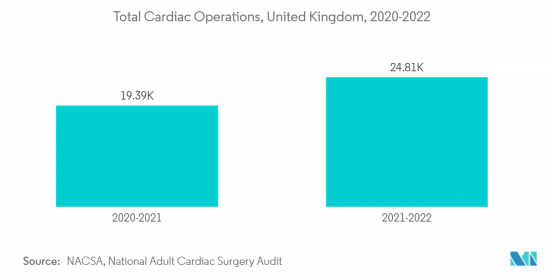
북미가 예측 기간 동안 큰 시장 점유율을 차지할 전망
- 북미는 신경질환의 이환율 증가, 노인 인구 증가, 더 나은 건강 관리 인프라, 이 지역 업계 기업들의 강력한 존재 등의 요인으로 인해 큰 시장 점유율을 유지할 것으로 예측됩니다.
- Cedars-Sinai가 2022년 1월에 업데이트한 데이터에 따르면, 관상동맥 우회 수술(CABG)은 관상동맥 우회 수술 또는 우회 수술로도 알려져 있으며, 가장 일반적인 심장 수술이며, 미국에서는 매년 30만명 이상이 우회 수술에 성공했습니다. 이처럼 미국에서는 CABG 수술 부담이 크므로 뇌체세포 산소 농도계의 유용성이 높고 기술적으로 첨단 제품을 개발할 기회도 생겨 이 부문의 성장을 가속할 것으로 예상됩니다.
- 또한 알츠하이머병 협회에 따르면 알츠하이머병을 앓고 있는 미국인의 수는 급속히 증가하고 있습니다. alzheimers.org의 데이터에 따르면 미국에서는 2021년 65세 이상의 미국인이 620만명으로 추정되어 알츠하이머 관련 치매를 앓고 있다고 합니다. 이와 같이 이 지역에서는 신경질환의 부담이 크므로 뇌의 산소 수준을 검출하는데 사용되는 뇌체세포 산소 농도계의 성장이 예상되어 시장 성장을 가속할 것으로 예측되고 있습니다.
- 또한 미국 국립위생연구소(NIH)의 Estimates of Funding for Various Research, Condition, and Disease Categories(RCDC), 2022 update에 따르면, 미국에서의 뇌성 마비의 연구비는 2021년에 3,000만 달러이며, 2022년에는 3,200만 달러에 달할 것으로 추정됩니다. 뇌체세포 산소 농도계는 일상적인 산소 수준 검출을 위해 이러한 질병에서 널리 사용됩니다. 질병 연구에 대한 지출이 많기 때문에 혁신적인 뇌체세포 산소 농도계의 개발 기회가 창출되어 예측 기간 동안 같은 지역 시장 성장을 뒷받침할 것으로 기대됩니다.
- 따라서 위의 모든 요인들 덕분에 조사된 시장은 이 지역에서 높은 성장을 보일 것으로 기대됩니다.
뇌체세포 산소 농도계 산업 개요
뇌체세포 산소 농도계 시장은 소수 시장 기업의 존재로 적당히 통합되어 있습니다. 대기업은 시장의 특정 분야에서 지위를 확립하고 있습니다. 또한 각 회사는 신흥 지역에서 세계 기업 및 기존 지역 기업과 경쟁하고 있습니다. 주요 기업은 기존 제품에 대항하기 위해 새로운 제품과 기술을 개발 및 발매하고 있는 한편, 시장에서 동향하고 있는 타사를 인수하거나 제휴하고 있습니다.
기타 혜택 :
- 엑셀 형식 시장 예측(ME) 시트
- 3개월간의 애널리스트 서포트
목차
제1장 서론
- 조사의 전제조건 및 시장 정의
- 조사 범위
제2장 조사 방법
제3장 주요 요약
제4장 시장 역학
- 시장 개요
- 시장 성장 촉진요인
- 뇌체세포 산소 농도계의 보급 확대
- 신경질환의 발생률 증가
- 시장 성장 억제요인
- 장치의 고비용
- Porter's Five Forces 분석
- 신규 참가업체의 위협
- 구매자 및 소비자의 협상력
- 공급기업의 협상력
- 대체품의 위협
- 경쟁 기업간 경쟁 관계의 강도
제5장 시장 세분화(시장 규모-달러)
- 유형별
- 듀얼 이미터 및 듀얼 디텍터
- 싱글 이미터 및 듀얼 디텍터
- 기타 유형
- 용도별
- 심장외과
- 혈관 수술
- 기타 용도
- 환자 유형별
- 소아과
- 성인
- 최종 사용자별
- 병원 및 클리닉
- 외래수술센터(ASC)
- 기타 최종 사용자
- 지역별
- 북미
- 미국
- 캐나다
- 멕시코
- 유럽
- 독일
- 영국
- 프랑스
- 이탈리아
- 스페인
- 기타 유럽
- 아시아태평양
- 중국
- 일본
- 인도
- 호주
- 한국
- 기타 아시아태평양
- 중동 및 아프리카
- GCC
- 남아프리카
- 기타 중동 및 아프리카
- 남미
- 브라질
- 아르헨티나
- 기타 남미
- 북미
제6장 경쟁 구도
- 기업 프로파일
- Medtronic PLC
- Nonin Medical Inc.
- Edwards Lifesciences
- ISS Inc.
- Masimo
- GE Healthcare Inc.
- Koninklijke Philips NV
- Mespere LifeSciences
제7장 시장 기회 및 앞으로의 동향
AJY 24.01.22
The Cerebral Somatic Oximeters Market size is expected to grow from USD 191.21 million in 2024 to USD 243.51 million by 2029, at a CAGR of 6.23% during the forecast period (2024-2029).
Key Highlights
- The cerebral somatic oximeters market was significantly affected by the COVID-19 pandemic. Since the onset of the pandemic, elective procedures were been postponed or canceled in many countries, along with disruptions in the supply chain of medical devices, especially in developing nations. For instance, an article published in the Brazilian Journal of Cardiovascular Surgery in May 2022 stated that the hospital staff at Main University Hospital, Egypt, were instructed to postpone new admissions from cardiac surgery outpatient clinics and to perform surgeries exclusively for patients currently admitted and emergencies during the pandemic. However, the market started to recover as non-essential medical procedures resumed gradually over the last two years around the world.
- The market for cerebral somatic oximeters is expected to witness healthy growth over the forecast period. The increase is majorly attributed to the rising incidence of neurological diseases and the growing adoption of cerebral oximeters in developed economies such as North America and Europe.
- According to an article published in the National Center for Biotechnology Information (NCBI) in April 2022, hypoxic-ischemic encephalopathy (HIE) is reported in 1 to 6 per 1000 live births in developed countries and 26 per 1000 live births in developing countries. The high burden of such neurological diseases propels the demand for cerebral somatic oximeters to detect the oxygen levels in the brain, thereby boosting market growth.
- In addition, cerebral oximetry is used routinely in some neonatal intensive care units (NICUs). For instance, as per an article published in Frontiers in Pediatrics Journal in April 2022, cerebral oximetry is utilized in the context of cardiac surgery and is used almost universally as a clinical routine in the perioperative care of newborn infants with congenital heart disease and neonatology. As per the article, currently, a clinical trial is ongoing to assess the importance of cerebral oximetry in severe brain injury in the neonatal department. The rising research studies are expected to propel the utility of cerebral somatic oximeters in the detection of oxygen levels of various brain and cardiac diseases during the forecast period.
- Furthermore, the strategic initiatives by market players, such as technological advancement leading to product approvals and launches, along with partnerships, are also contributing to the market growth during the forecast period. For instance, in December 2021, Medtronic PLC received Food Drug Administration (FDA) 510(k) approval for its INVOS 7100 cerebral/somatic oximetry system for pediatric indications. The INVOS system helps pediatric clinicians make time-sensitive decisions regarding ventilation, hemodynamic management, and resuscitation for neonates, premature infants, children, and other patients treated by them. Therefore, the launch of the technologically advanced cerebral oximeters for the pediatric population is expected to widen its customer base and add growth to the cerebral somatic oximeters market during the forecast period.
- Therefore, owing to the aforementioned factors, such as the high burden of neurological diseases and technologically advanced product approvals, the cerebral somatic oximeters market is anticipated to witness growth over the analysis period. However, the high cost of the device due to the expensive sensors used in the cerebral oximeters is estimated to restrain the market growth.
Cerebral Somatic Oximeters Market Trends
Cardiac Surgery is Expected to Hold a Significant Market Share Over The Forecast Period
- Cardiovascular surgeries, by application, are expected to hold a significant market share in the cerebral oximetry market during the forecast period. The increased demand for these devices in aortic surgery, arrhythmia surgery, myomectomy, and coronary artery bypass graft (CABG) procedures can be attributed to their ability to minimize the risk of complications and reduce anastomotic leaks.
- The major factors attributing to the growth of cerebral oximeters are a deskbound lifestyle lacking physical activity, lack of proper diet, anxiety, and stress resulting in chronic diseases, thereby leading to the prevalence of multiple cardiovascular diseases (CVD). For instance, according to the Centers for Disease Control and Prevention (CDC), National Center for Health Statistics, 2022 update, angina was reported in 1.5% of the adult population aged 18 and over in the United States.
- Also, according to the Australian Bureau of Statistics, March 2022 update, the prevalence of heart disease in Australia was 4.0%, which represented 1.0 million people in 2021. Heart diseases such as angina, heart attack, stroke, and other cardiovascular diseases were more common in males than females (4.9% compared to 3.1%). Thus, the high burden of cardiovascular diseases worldwide is expected to lead to a high number of CABG procedures worldwide, which is expected to propel the segment growth during the forecast period.
- Furthermore, a research article published in PLOS One Journal in December 2021 stated that the cerebral oximeter is frequently used to detect changes in cerebral oxygen saturation and cerebral ischemia during cardiac surgery. As per the same source, between 25% and 80% of patients who underwent major heart surgery experienced postoperative neurocognitive impairments (POND) during the course of the study. During major cardiac surgery, the use of a cerebral oximeter is crucial to predicting the onset of POND. The study also suggested that increased cerebral oximeter levels during cardiac surgery may also be a risk factor for POND. Thus, the high utility of cerebral somatic oximeters in research studies is expected to propel its demand during cardiac surgery, which is projected to augment segment growth.
- Therefore, the high burden of cardiac surgery performed worldwide, along with the use of cerebral oximeters in cardiac surgery, is significantly impacting the growth of the segment during the forecast period.

North America is Expected to Hold a Significant Market Share Over The Forecast Period
- North America is expected to hold a significant market share owing to factors such as the rising incidence of neurological diseases, the growing geriatric population, better healthcare infrastructure, and the strong presence of industry players in the region.
- The data updated by Cedars-Sinai in January 2022 reported that coronary artery bypass graft surgery (CABG), also known as coronary artery bypass or bypass surgery, is the most common heart surgery and more than 300,000 people have successful bypass surgery in the United States each year. Thus, the high burden of CABG procedures in the United States is expected to propel the high utility of cerebral somatic oximeters and also create opportunities for developing technologically advanced products, propelling the growth of the segment.
- Furthermore, according to the Alzheimer's Association, the number of Americans living with Alzheimer's is growing rapidly. The data from alzheimers.org suggested that in 2021, in the United States, an estimated 6.2 million Americans aged 65 and older were living with Alzheimer-related dementia. Thus, the high burden of neurological diseases in the region is expected to propel the growth of the cerebral somatic oximeters used for the detection of oxygen levels of the brain, which is projected to propel the market growth.
- In addition, as per the National Institute of Health (NIH) Estimates of Funding for Various Research, Condition, and Disease Categories (RCDC), 2022 update, the research spending on cerebral palsy was USD 30 million in 2021 and estimated to be USD 32 million in 2022 in the United States. Cerebral oximeters are widely used in these diseases for routine oxygen level detection. The high spending on the research of diseases is expected to create opportunities for developing innovative cerebral somatic oximeters, thereby boosting market growth in the region during the forecast period.
- Thus, owing to all the above-mentioned factors, the market studied is expected to witness high growth in the region.
Cerebral Somatic Oximeters Industry Overview
The cerebral somatic oximeters market is moderately consolidated in nature due to the presence of few market players. The major players have established themselves in specific segments of the market. Furthermore, the companies are competing in emerging regions with global players and with established local players. Key players are developing and launching novel products and technologies to compete with existing products, while others are acquiring and partnering with other companies trending in the market. Some key players are Masimo, Medtronic Plc, Edwards Lifesciences, Nonin Medical, Inc., ISS Inc., GE Healthcare Inc., Koninklijke Philips N.V., and Mespere LifeSciences.
Additional Benefits:
- The market estimate (ME) sheet in Excel format
- 3 months of analyst support
TABLE OF CONTENTS
1 INTRODUCTION
- 1.1 Study Assumptions and Market Definition
- 1.2 Scope of the Study
2 RESEARCH METHODOLOGY
3 EXECUTIVE SUMMARY
4 MARKET DYNAMICS
- 4.1 Market Overview
- 4.2 Market Drivers
- 4.2.1 Incrreasing Adoption of the Cerebral Oximeters
- 4.2.2 Rising Incidence of Neurological Diseases
- 4.3 Market Restraints
- 4.3.1 High Cost of the Device
- 4.4 Porter's Five Forces Analysis
- 4.4.1 Threat of New Entrants
- 4.4.2 Bargaining Power of Buyers/Consumers
- 4.4.3 Bargaining Power of Suppliers
- 4.4.4 Threat of Substitute Products
- 4.4.5 Intensity of Competitive Rivalry
5 MARKET SEGMENTATION (Market Size by Value - USD)
- 5.1 By Type
- 5.1.1 Dual Emitter and Dual Detector
- 5.1.2 Single Emitter and Dual Detector
- 5.1.3 Other Types
- 5.2 By Application
- 5.2.1 Cardiac Surgery
- 5.2.2 Vascular Surgery
- 5.2.3 Other Applications
- 5.3 By Patient Type
- 5.3.1 Pediatrics
- 5.3.2 Adults
- 5.4 By End-User
- 5.4.1 Hospitals and Clinics
- 5.4.2 Ambulatory Surgical Centers
- 5.4.3 Other End-Users
- 5.5 Geography
- 5.5.1 North America
- 5.5.1.1 United States
- 5.5.1.2 Canada
- 5.5.1.3 Mexico
- 5.5.2 Europe
- 5.5.2.1 Germany
- 5.5.2.2 United Kingdom
- 5.5.2.3 France
- 5.5.2.4 Italy
- 5.5.2.5 Spain
- 5.5.2.6 Rest of Europe
- 5.5.3 Asia-Pacific
- 5.5.3.1 China
- 5.5.3.2 Japan
- 5.5.3.3 India
- 5.5.3.4 Australia
- 5.5.3.5 South Korea
- 5.5.3.6 Rest of Asia-Pacific
- 5.5.4 Middle East and Africa
- 5.5.4.1 GCC
- 5.5.4.2 South Africa
- 5.5.4.3 Rest of Middle East and Africa
- 5.5.5 South America
- 5.5.5.1 Brazil
- 5.5.5.2 Argentina
- 5.5.5.3 Rest of South America
- 5.5.1 North America
6 COMPETITIVE LANDSCAPE
- 6.1 Company Profiles
- 6.1.1 Medtronic PLC
- 6.1.2 Nonin Medical Inc.
- 6.1.3 Edwards Lifesciences
- 6.1.4 ISS Inc.
- 6.1.5 Masimo
- 6.1.6 GE Healthcare Inc.
- 6.1.7 Koninklijke Philips N.V.
- 6.1.8 Mespere LifeSciences





